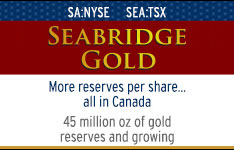IMF: Australia Recovery on Track, Led by Mining
Source: Reuters, Lesley Wroughton and Neil Stempleman (10/28/10)
"Mining boom was likely to continue, given demand from Asian economies."
Australia may need to tighten monetary policy further to contain inflation pressures being generated by a mining boom, the IMF said on Thursday.
The IMF's annual review of Australia's economy said the recovery was on track, led by strong demand for its commodities from China and India.
It said gross domestic product growth was projected to reach 3% in 2010 and 3.5% next year. Staff assessments estimated that the Australian dollar AUD=D4 may be overvalued by somewhere between 5 to 15%.
Authorities agreed in discussions that if further inflation pressures emerged, they will need to raise rates further.
The IMF said private investment in mining and commodity exports had overtaken public demand as the main driver of growth in Australia. The mining boom was likely to be long lasting, it said, given demand by for commodities from fast-growing Asian economies.
The IMF said the authorities agreed in discussions that the commodities boom will test the economy's capacity and fiscal policy had so far played a key role in managing the boom.
The IMF said it approved of the pace at which the central bank was unwinding monetary stimulus.
"Should the global recovery stall, the (central bank) has scope to cut the policy rate," the IMP said added.
The Reserve Bank of Australia has raised the policy rate to 4.5% in six steps, the most recent in May.
The fund said it also supported government plans to return to a budget surplus of 0.2% of GDP by 2012/13. It noted that a larger surplus than in the past may help avoid potential overheating and offer protection from sharp falls in commodity prices.
The IMF said a fall in prices for houses, which could be somewhat overvalued, according to staff assessments, could affect private consumption and slow the recovery in Australia.
The IMF's annual review of Australia's economy said the recovery was on track, led by strong demand for its commodities from China and India.
It said gross domestic product growth was projected to reach 3% in 2010 and 3.5% next year. Staff assessments estimated that the Australian dollar AUD=D4 may be overvalued by somewhere between 5 to 15%.
Authorities agreed in discussions that if further inflation pressures emerged, they will need to raise rates further.
The IMF said private investment in mining and commodity exports had overtaken public demand as the main driver of growth in Australia. The mining boom was likely to be long lasting, it said, given demand by for commodities from fast-growing Asian economies.
The IMF said the authorities agreed in discussions that the commodities boom will test the economy's capacity and fiscal policy had so far played a key role in managing the boom.
The IMF said it approved of the pace at which the central bank was unwinding monetary stimulus.
"Should the global recovery stall, the (central bank) has scope to cut the policy rate," the IMP said added.
The Reserve Bank of Australia has raised the policy rate to 4.5% in six steps, the most recent in May.
The fund said it also supported government plans to return to a budget surplus of 0.2% of GDP by 2012/13. It noted that a larger surplus than in the past may help avoid potential overheating and offer protection from sharp falls in commodity prices.
The IMF said a fall in prices for houses, which could be somewhat overvalued, according to staff assessments, could affect private consumption and slow the recovery in Australia.


















































